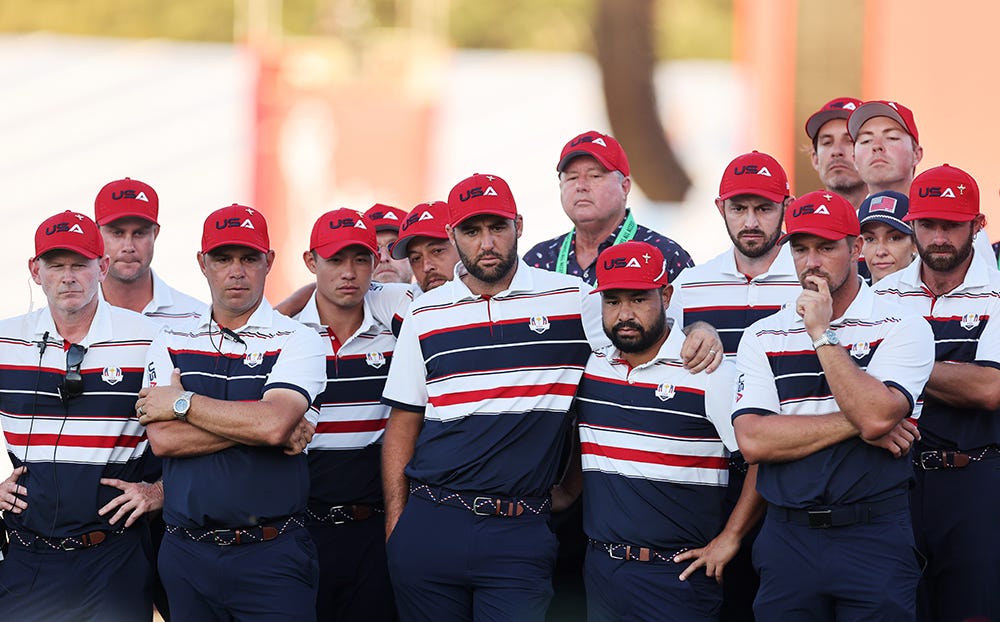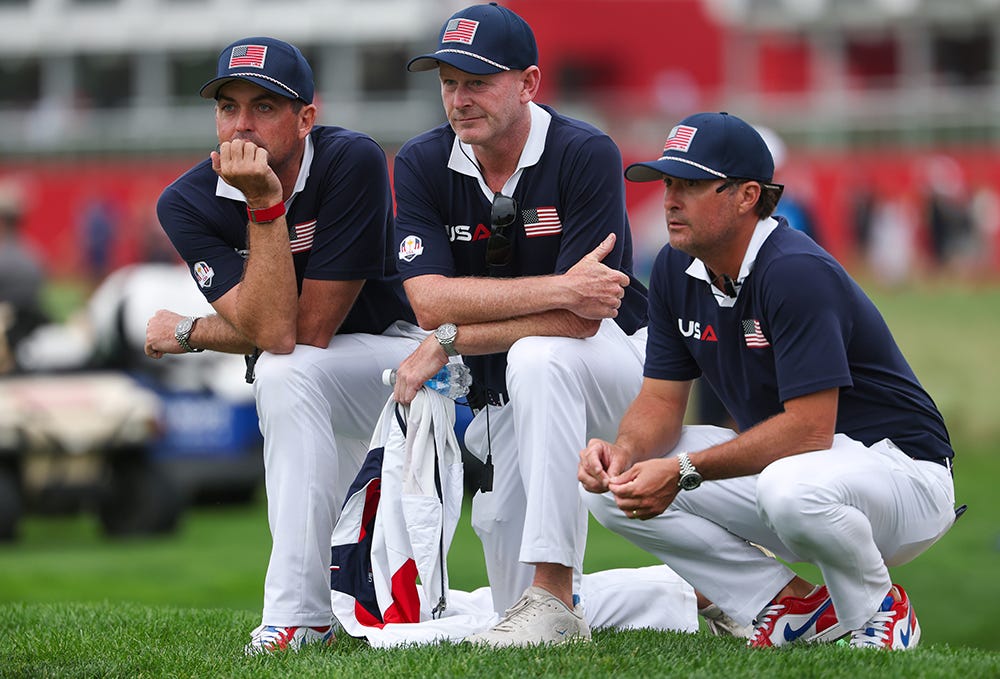Resisting knee-jerk plea to 'blow it up'
Prez Cup captain Sneds sees value in Ryder Cup lessons; Stray Shots look back/ahead
Brandt Snedeker (left) and the U.S. team watch disappointing finale at Bethpage (Michael Reaves/PGA of America)
The aftermath of the Ryder Cup is always so intriguing. It’s a three-day event, staged every two years, but the second-guessing never stops.
But the Ryder Cup is not a season-long competition. It isn’t like being able to judge a baseball manager or a football coach. Those team leaders have a plethora of decisions over the course of weeks and months that can be dissected.
Not so much for the Ryder Cup, which has half the team decided without input and the rest based on various metrics. How to put them in partnership team settings, of course, is the stuff of considerable conjecture, and after another U.S. defeat, there are understandably calls to blow the whole thing up.
Time to take a deep breath.
For all the various mistakes made at Bethpage Black — the biggest likely the course set up, which captain Keegan Bradley acknowledged — it’s difficult to see how some huge change of structure would change anything.
Yes, we can debate several of the pairings. That always happens in defeat. It needs to be examined. So, too, does the U.S. approach to the foursomes format, which has been a disaster in two consecutive Ryder Cups.
But tear it apart?
Brandt Snedeker, a vice captain for Bradley who will serve as the U.S. Presidents Cup captain next year, believes that would not be wise.
“I think having guys kind of serve underneath a captain [is important] so they understand what they’re getting themselves into, so when they do step in that captaincy role, they’re more prepared and understanding of what’s going to go into that whole week and really the year build-up to,” said Snedeker about the system already in place to groom future captains.
“So I think that continuity is important, something that the task force has kind of been put in charge of and I hope they kind of keep going down that path.”
The “task force.” Highly ridiculed in late 2014 when it was first unveiled, it had a dozen some members, including Tiger Woods and Phil Mickelson.
But for all the snickers, what came out of it was a plan to see continuity from the Presidents Cup to the Ryder Cup, using both events as a way to find consistency among captains, vice captains and even players.
And, for the most part, that has worked. The U.S. has continued to dominate the Presidents Cup. It won two Ryder Cups at home in routs. Assistants and captains have served on both.
Bradley became the outlier when he was named captain in July of 2024 — a deviation from the task force plan. He had never served as an assistant. He hadn’t even been involved in the Ryder Cup for 10 years.
Captain Keegan Bradley with assistants Brandt Snedeker and Kevin Kisner (Jamie Squire/Getty Images)
But he played on the 2024 Presidents Cup team, and six other players from that squad were on this year’s Ryder Cup team. Jim Furyk was the captain and served as an assistant to Bradley this year.
It seems the personnel isn’t the issue. Perhaps there simply needs to be a deeper dive into what is going on — aside from the simple fact that the best American players were not very good at delivering points at Bethpage Black.
“The one thing we have that is unique is we do this every year. We do it with two different organizations,” Furyk said of the separate international team events conducted by the PGA of America and the PGA Tour. “But for the players, it’s still Team USA. It’s trying to hand down some knowledge and to keep a lot of symmetry from year to year. And that’s kind of what we do.”
Furyk noted that the Ryder Cup has been going back and forth for a decade before the Europeans won for the second straight time.
“You’re always going to have a knee-jerk reaction for whoever it might be,” he said. “There’s going to be that cry to break things down and start over. That’s kind of what we did in 2014 with the task force. Can we get better as an organization? Yes. But I don’t think you break everything down and start over. If you keep building toward the ultimate goal and we can get there.”
Furyk, the 2018 Ryder Cup captain, has been an assistant four times. He’s also been an assistant captain for the Presidents Cup twice. He said he has not spoken to Snedeker about serving in that role again next year, but it makes some sense if you want there to be a smooth transition and build toward 2027.
Does the Presidents Cup help or hinder? That question has also come up recently. Geoff Ogilvy, who will captain the International team at the Presidents Cup next year when it is played at Medinah outside of Chicago, wondered as well.
“It would work either way,” said Ogilvy, who won the 2006 U.S. Open and went 7-6-1 in three Presidents Cup appearances. “It’s interesting that I was hearing (former European captain) Paul McGinley on the broadcast say they used to have the Seve Trophy in between (Ryder Cups). And they got rid of it and then they brought it back (now called the Team Cup) because they felt there was an advantage in doing that.
“I think it’s how you use that one every year and use it to their advantage.”
Snedeker, 44, who has nine PGA Tour victories, now has two Cups under his belt as an assistant in addition to the three he played in. It makes sense that he utilizes what he learned at Bethpage and then try to pass that along afterward.
“The captain always seems to get the praise or the blame,” Snedeker said. “But all the successful teams are always a collective of combined knowledge of everybody. There’s a lot of pieces to the puzzle.”




